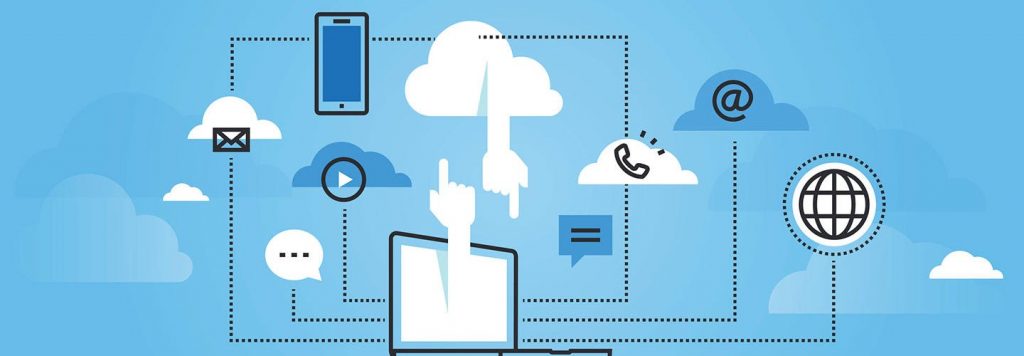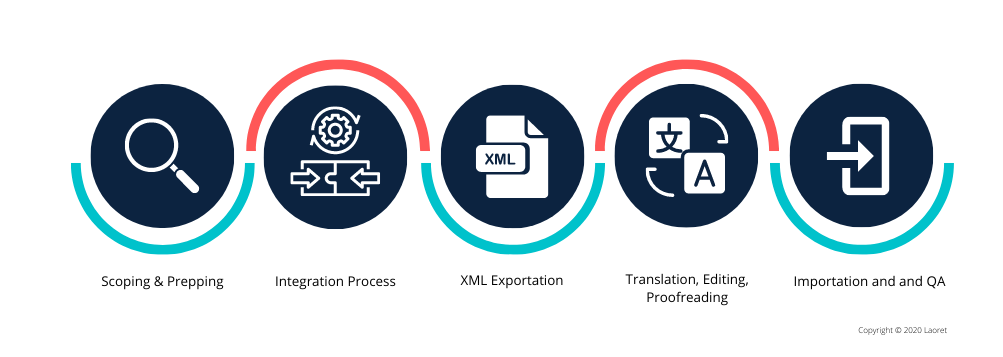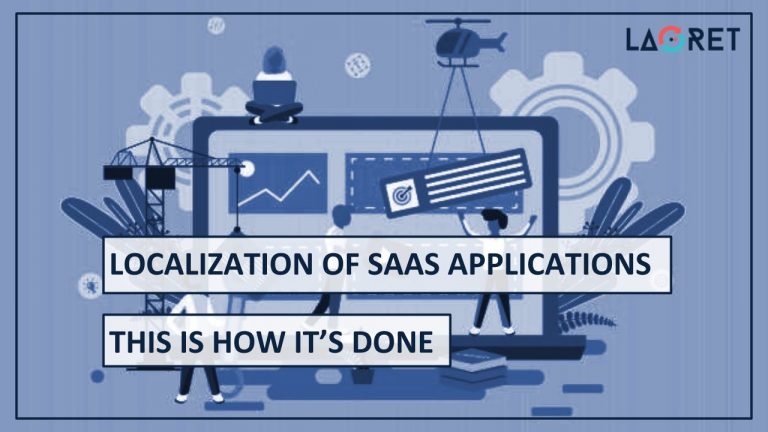Localization Of SaaS Applications: This Is How It’s Done
Effective SaaS Solutions are here to stay. With expected revenue of around 105 billion USD in 2020 1 the easy to use and affordable cloud-based applications are a big hit. With a rise in global revenue comes a demand for qualitative localization solutions.
That is why we decided to write a blog to resolve the confusion once and for all. Read on and learn about how Saas Localization requires specialized Software Localization, and that only a combination of the most suitable tools, customized integrations, and a well-balanced team will get you the desired result.
The Optimized SaaS Localization Process
Considering a SaaS Application’s cloud-based function, we often receive a request for Website Localization. However, a website and SaaS Application are built with a completely different purpose in mind. While websites are often developed using a Content Management System (CMS), a SaaS Application is actually a cloud-based software that offers specific services online. This means that the software itself needs to run smoothly on any device and in any locale, in terms of visuals, layout, and User Experience (UX).
There are three main ways to keep in mind when executing the translation for your SaaS application.
1- Export & Import from your Repository: assuming that you can export and import content from the back-end of your application, You may export your UI content in CSV, JSON, XML, HTML, YAML, PO, XLIFF, etc.
2- Connect to your Code Repository: You can pull your UI content straight from your Code Repository. i.e. Github, Bitbucket, Sourceforge, Launchpad, etc. or from your cloud-networked storage i.e. Dropbox, Sharepoint, Google Drive, etc. using a ready-made translation connector.
3- Connect through an API: if your application has an API, you may connect it directly with a Translation Management System (TMS)
With this in mind, let us expand on the ideal localization process for your SaaS Application from the initial preparations, to the final Quality Assurance (QA).
Scoping And Preparations
- First things first. Does your SaaS Application have an API? This is essential because if you will be adding more features and content on a regular basis, you will need a translation integration to link between your application and the Translation Management System (TMS) of your Language Service Provider (LSP). This means that the strings are extracted directly from the source code as soon as it is published, and the localized content will be integrated again automatically.
- Estimate the scope of your project. When planning on translating your UI, you always have to keep the buyer’s journey in mind and remember each crucial step your customers will take in order to get results. You will need to localize the content itself, but also the prices, payment options, images, menus, and so on.
- Note that different types of content will require different translation types. For example, would you need to localize marketing content to launch your new product? If you need localized marketing messages, you may require transcreation services in this case. Note that this will also include any landing pages you have set up to promote your product. Read more about it in our blog on how transcreation is best managed!
Pro Tip! We offer customized integrations between your Content Management System (CMS) and our TMS and Translation CAT-Tools! Reach out to us if you would like to learn more!

Exporting Your Content: Why XML Works best
When it comes to exporting your content to then deliver to an LSP, there are several options available such as CSV, XML, and JSON, to name a popular few. And out of this list, XML is the most translation-friendly format that will get you the best and most cost-effective results.
So, why not CSV? A common misconception we have encountered with clients looking for SaaS Localization or Software Localization, is that they assume they are making it easier for the LSP by sharing a csv file. But since CSV files would normally contain shortcodes and regular expressions and untranslatable content. It might be a little difficult to prepare for translation and it can very easily lead to errors and inefficient translation workflows.
On the other hand, XML files can more easily be prepared for translation. The CAT Tool can be applied to exclude any tags, short-codes and regular expressions, leaving only the translatable content without compromising the code structure. Ideally, this step should be performed by a localization Engineer. Not only will this method help you avoid a possible minefield of bugs and issues, but you will also get a more friendly price tag since the translation cost is charged per word.
Pro Tip! Learn more about the pitfalls prevented by the correct usage of Regular Expressions.

The Translation Process
A streamlined translation process actually starts before the linguist even starts to work on the text. In this, you have to make sure the vendor you choose to work with makes use of the above-mentioned CAT Tool and that their localization engineer can effectively apply the translation groundwork. This way, the linguist is presented with a fresh copy that will boost both efficiency and output quality.
When it comes to the tool itself, it should be optimized for SaaS Localization:
- Set the Max Length or characters limitations. This is to help translators and localization engineers deliver a product free of errors. This includes setting up parameters for possible text expansion and contraction during the translation stage. This has been a crucial development since SaaS Applications have gone mobile and the content needs to fit smaller screens while still being accurate and readable.
- Offer a centralized platform that is 100% online
- Go with API integration “when possible“ to automate the localization process and make it Agile
- Leverage specialized human translations
- Create a Glossary, a master list of your technical and product-related terms along with their approved translations
- Use a Style Guide with Brand-Specific Instructions
- Use a Translation Memory (TM) to archive your translations. This will increase productivity, save cost, and maintain the best quality by weeding out any potential inconsistencies in your translations.
Pro Tip! Did you know that some languages can take up to 30% more space than others when translated? When not managed correctly, this can cause critical issues that can undermine the User Experience (UX) and well as the performance of your application. Read our blog on managing Text Expansion for Software and Game Localization and learn all about it!
When all these features are set up correctly, the content is subjected to a rigorous TEP (Translation, Editing, Proofreading) Process.
How Can Multilingual Software Localization
Be Both Qualitative And Cost-Effective?
Get your Free eBook listing the best practices and practical tips on how you can help save both time and money!
Quality Assurance During Translation
An ideal Software Localization Process will have QA inserted in every step of the process within a streamlined workflow. And when it comes to the Translation Stage, suitable Translation Technologies will be paramount as they are built to support:
- Software Simulation where the translators can see the content in its original context during the translation process. This way, the process remains cost-effective and industry-specific challenges can be overcome, such as estimating the lens of the translation.
- Detecting errors caused by possible missing variables or formatting. The translation of help files, the UI, and technical documentation should run seamlessly together for the service to be cost-effective and consistent.
- Continuous translation which is made possible by the application of the above-mention translation connector. Even when adhering to an agile system, localization and coding challenges can cause quite a headache. But with continuous localization, bugs and errors can be resolved more quickly, repetitive tasks can be automated, and new content can be imported and extracted routinely. Continuous localization is the method that can keep up with the agile software development process and will increase productivity while reducing errors.
Final Quality Assurance And Testing
The most effective way in determining the quality of your translation is by testing the software product in a runtime environment.
During this stage, both the linguists and localization engineers will be engaged in reviewing the localization quality. The localization engineers will be zoned in on the workings of the UI and the compatibility and functionality of the software. The linguistic reviewers will evaluate the content and cosmetic qualities of the software, to ensure a culturally and linguistically potent user experience.
Frequently Asked Questions
Do you still have some questions about SaaS Application Localization, or would you like some general information to get a better idea of how you can get the best translation and localization services out there? Then have a look at our Frequently Asked Questions section!
How do I get a good translation service?
The best translation services are adapted to your needs. Pay attention to the provider’s expertise in your industry, their turnaround time, and their reputation for delivering quality translations. Also make sure that your provider works with native, in-country experts exclusively, and utilizes the most innovative tools on the market.
What is the best way to translate SaaS?
The translation of your Saas Application should be approached from the perspective of Software Localization. It is essential that the content, the visuals, as well as the software environment are optimized and work together smoothly. This means your provider should have technical as well as linguistic expertise.
How do SaaS startups manage translations?
Every SaaS startup should start by scoping their project and select translatable content and target languages. The best approach will be to team up with a qualified vendor who has a thorough knowledge of your target locale, software localization and your specific industry.
Conclusion:
Localizing your SaaS product can be done in a highly effective and qualitative manner through the use of the correct tools, an expert team with technical and linguistic authority, and a solid integration process.
At Laoret, we put together teams of tech-savvy localization engineers and in-country, native linguists with a solid background in your industry. With our intuitive, cloud-based TMS, customized integrations, and locally designed technologies, we can adapt our services to our clients’ needs. Benefit from our 24/7 availability and get in touch with us for your next SaaS Localization process!






